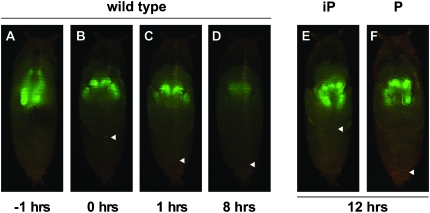Figure 1.—
Salivary gland-specific GFP expression provides a marker to follow cell death in wild-type and mutant pupae. Salivary gland-specific GFP expression is clearly visible in wild-type late prepupae ∼1 hour before adult head eversion (AHE) (A), as well as a few minutes (B) or 1 hr after the onset of head eversion (C), but is significantly reduced by ∼8 hr AHE (D) due to cell death. This GFP expression persists at 12 hr AHE in mutant pupae in which salivary gland cell death is disrupted (E and F). The adult legs normally extend to full length at head eversion (marked by arrowheads in B and C) and maintain this length through pupal stages (arrowhead, D). Mutations in general regulators of ecdysone responses, like rbp5, block leg elongation as well as salivary gland cell death (E), resulting in incomplete pupation (iP), while mutations recovered from the pilot screen, such as CBP, show normal leg elongation and head eversion despite the disruption of salivary gland cell death (F), resulting in relatively normal pupation (P).

